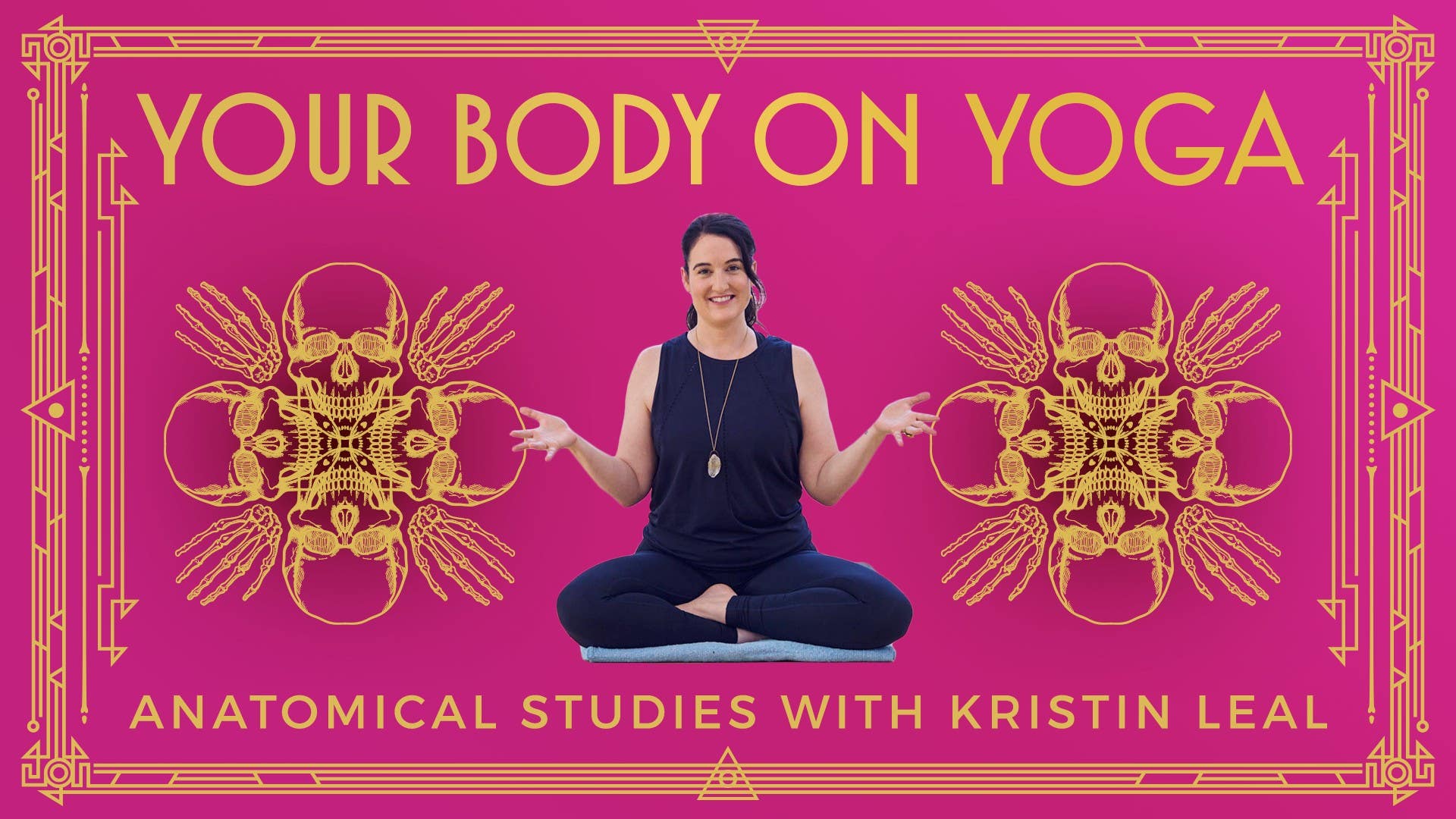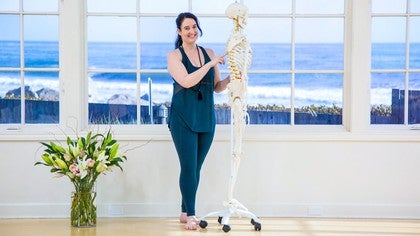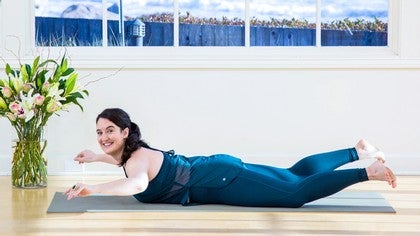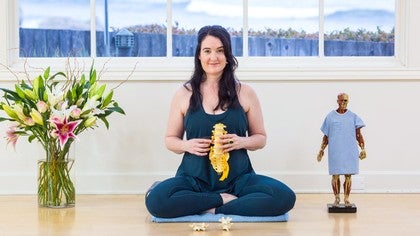Description
Please see the attached .pdf for a chart of the spine and detailed view of the vertebrae.
About This Video
Transcript
Read Full Transcript
So even though you might have heard your mother say straighten your spine, or you might have even heard your teacher say something like, inhale flat back, our spines aren't straight or flat. They have these beautiful kind of sexy curves to it. And those curves are meant to be supported, strengthened, and celebrated rather than just flattened or diminished or ignored. In our bodies, we have in this inner architecture of the spine, not just one hunk of bone, but we have 24 individual chains that make up this interconnected spinal column or vertebral column. Each of these little bones can be subdivided into regions, and each region will have something that it's really good at and something that it's less good at, just depending on all the little bits and pieces that come out of it.
These 24 individual vertebra can be subdivided into four regions. We have our cervical vertebra, and you actually have seven cervical vertebra. I remember it like you have breakfast at seven. Then we have our thoracic vertebra. There are 12 that make up or comprise the thoracic region, and I remember it like lunches at noon, lunches at 12.
You have this lower back or lumbar region. There are five that comprise the lumbar region, and that's kind of too early for a dinner where I'm from. So sometimes we'll say happy hour or tea time, whatever your preference is at five. So we have five lumbar vertebra. And then you have very unique bones called the sacrum, this kind of pyramid-shaped bone, and the tailbone, or coccyx, that we're going to go through in a different episode because they're just so wildly unique and beautiful, they're worth their own time.
These 24 individual bones can be subdivided into these regions because we have four curves of our adult spine. Our cervical curve curves towards our throat. So it's called a concave curve or a lordotic curve in anatomy language. This thoracic curve goes the other direction. It rounds towards the wall behind you.
These 12 vertebra, this rounded upper spine, is called a kyphotic or convex curve. This lumbar curve opposes by going towards your belly button, rounding in this concave curve or lordotic curve. And then the sacrococcygeal curve curves towards the pubic bone. So it's a convex or kyphotic curve. So you have two lordotic curves, two kyphotic curves to make up this beautiful, elegant, wavy spinal column.
Now sometimes you can have an exaggeration of these curves. You might see someone who's really rounded in the upper back as an excess thoracic kyphotic curve. And sometimes we just casually refer to that as, whoa, she's really kyphotic. You might see someone who's got a very excess lumbar curvature, a lordotic curve. And sometimes simply we just say, whoa, she's really lordotic.
Not to their face, but we say it. So these excess curvatures are something that we can address in a yoga practice. There's another type of deviation that might occur where it's not an anterior to posterior deviation, but more of a lateral and rotational deviation. That's something called scoliosis. Now primary scoliosis is something that's kind of in the genetic cards for some.
And it starts to develop as we develop. And as we grow, there starts to become a lateral offsetting of the vertebra, and it always comes with a rotational component as well. Now this can be simply in one region of the spine, kind of a C-shape curvature. And sometimes it's a little bit more complex, having two or more regions of the spine causing a S-shape appearance to occur. Now that's the primary scoliosis, the genetic one.
And then sometimes you might hear people start to refer to their own habitual asymmetry as a type of scoliosis, a secondary scoliosis. And this is something that's brought on by our habitual actions. I carry my bag more comfortably on my right shoulder, or I always step forward off of a stair with one foot, or I'm driving in a car and always looking over one shoulder. This is something that builds up muscularly in the body, and the body compensates and has habits and tension and weakness just because of our daily activities. The muscles will pull on the bones, causing them to appear as if they're out of line.
But as we address those muscles, the spine will move back into this more classic shape. Now two of these curves we're born with, and that's the thoracic and sacrococcygeal. And so these are sometimes referred to as the primary curves. And then two of these curves are developed, as we develop. And these are called the secondary curves, the cervical and the lumbar.
The cervical and lumbar are also termed sympathetic curves. Now if you know about the nervous system, this doesn't have anything to do with that word sympathetic that arrives in our nervous system, but rather like a sympathetic friend. They're sympathetic to one another. So when one moves, the other moves. And you can do it in your chair or wherever you're sitting right now.
If you tip your head back, causing extension in your cervical, there's a sympathetic action in your lower back, your lumbar spine that will go along. Or conversely, if you start to round your lumbar spine into flexion, there's a sympathetic action of your neck that goes along for the ride. This is something that's really useful information for a yogi, because it's very hard sometimes to adjust your own lower back in some of these fancier poses, like an upper dog or a big back bend. And so just by adjusting your head, you can create more space in the lower spine. And we tend to kind of throw our head back sometimes to feel a pose not the greatest for our neck, but also not the greatest for our lower back.
We like to, again, subdivide to take notes or to put things in categories. But when we reunite to this beautiful, curvy, interconnected vertebral column, we can find the strength and support we need, we desire, and we deserve.
Your Body on Yoga: Torso
Comments
You need to be a subscriber to post a comment.
Please Log In or Create an Account to start your free trial.












